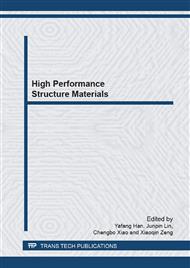[1]
T. Furuhara, T. Maki, T. Makino, Microstructure control by thermo mechanical processing in β-Ti-15-3 alloy, Journal of Materials Processing Technology. 117(2001) 318-323.
DOI: 10.1016/s0924-0136(01)00790-7
Google Scholar
[2]
R. R. Boyer. An overview on the use of titanium in the aerospace industry, Materials Science and Engineering: A. 213(1996) 103-114.
Google Scholar
[3]
Wang Qingru, Zhang Qingling, Chen Yuwen, et al., Ti-15-3 Alloy Property Data, Journal of Materials Engineering. 11(1996)17-21.
Google Scholar
[4]
Shan Debin, Lu Yan, Li Ping, et al., Experimental study on progress of cold-power spinning of Ti-15-3 alloy, Journal of Materials Processing Technology. 115(2001) 380-383.
DOI: 10.1016/s0924-0136(01)00827-5
Google Scholar
[5]
Huang Tianze, Song Li, Yang Jian. A summary on sheet metal bending spring-back analysis and engineering control, Forging & Stamping Technology. 1(1996)18-22.
Google Scholar
[6]
Chen Yuxun. Control principles and methods for bending spring-back of plates and profiles, National Defence Industry Press, Beijing, (1990).
Google Scholar
[7]
Liu Bin, Wang Minjie, Liu Qingqing. V-shaped bending spring-back influencing factors and experimental Study, Forging & Stamping Technology. 5(2002) 22-25.
Google Scholar
[8]
Hu Aiping, Wang Ping, Li Dezun. Influencing factors and contrl methods for bending spring-back workpeice, Aerospace Manufacturing Technology. 2(2007) 57-59.
Google Scholar
[9]
Chang Rongdai, Chen Xiaodai. Research and experiments on strengthening metal sheet formability, Aviation Manufacturing Engineering. 2(1984) 2-10.
Google Scholar
[10]
D. G. Sanders, M. Ramulu, P. D. Edwards, et al., Characterization of Super plastically Formed Friction Stir Weld in Titanium 6AL-4V: Preliminary Results, Materials Engineering and Performance. 17(2008)187-192.
DOI: 10.1007/s11665-007-9186-0
Google Scholar
[11]
Hong Quan, Luo Guozhen, Zhang Shunqi, et al., Study on the relationship between process, property and grain size for Ti-15-3 alloy, Journal of Materials Engineering. S1(1992)170-171.
Google Scholar
[12]
Wang Kaidong, Zeng Weidong, Shao Yitao, et al., Quantitative analysis of the titanium alloy microstructure based on the principle of stereology, Rare metal materials and engineering. 38(2009) 398-403.
Google Scholar
[13]
Ӧzgür Tekaslan, Nedim Gerger, Ulvi Seker. Determination of spring-back of stainless steel sheet metal in V, bendinding dies, Materials and Design. 29(2005)1043-1050.
DOI: 10.1016/j.matdes.2007.04.004
Google Scholar
[14]
Z.Q. Jiang, H. Yang, M. Zhan, et al., Coupling effects of material properties and the bending angle on the springback angle of a titanium alloy tube during numerically controlled bending, Materials and Design. 31(2010) 2001–(2010).
DOI: 10.1016/j.matdes.2009.10.029
Google Scholar
[15]
W.M. Chan, H.I. Chew, H.P. Lee, et al., Finite element analysis of spring-back of V-bending sheet metal forming process, Journal of Materials Processing Technology. 148(2004)15-24.
DOI: 10.1016/j.jmatprotec.2003.11.038
Google Scholar
[16]
Sutasn Thipprakmas, Surasit Rojananan. Investigation of spring-go phenomenon using finite element method, Materials and Design. 29(2008)1526-1532.
DOI: 10.1016/j.matdes.2008.02.002
Google Scholar
[17]
Sutasn Thipprakmas, Wiriyakorn Phanitwong. Process parameter design of spring-back and spring-go in V-bending process using Taguchi technique, Materials and Design. 32(2011)4430-4436.
DOI: 10.1016/j.matdes.2011.03.069
Google Scholar


